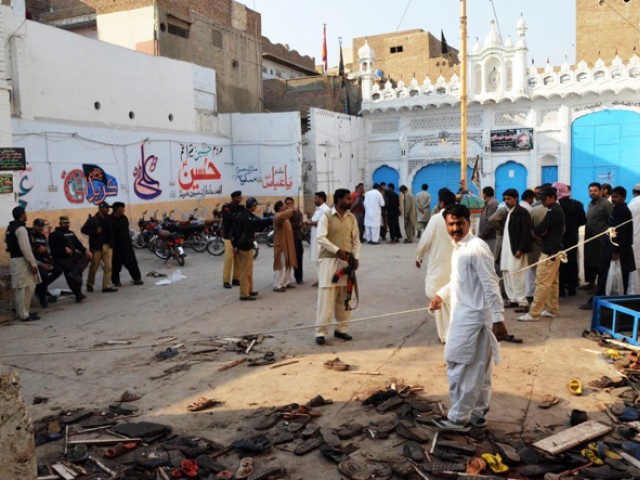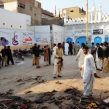
Growing Islamic State Influence in Pakistan Fuels Sectarian Violence
Publication: Terrorism Monitor Volume: 13 Issue: 13
By:

A seemingly organized sectarian violence against Pakistan’s beleaguered minority Shi’a community has plumbed new depths in recent months with a series of bombings of Shi’a worshipping places and targeted killings that have left over 170 people dead so far in 2015. Previously the anti-Shi’a armed campaign was spearheaded by banned Sunni militant groups like Sipah-e-Sahaba, Lashkar-e Jhangvi (LeJ) and Jundallah, which all are closely affiliated with Taliban conglomerate the Tehrik-e-Taliban Pakistan (TTP–the Pakistani Taliban). However, with the arrival of Islamic State in Pakistan’s jihadist landscape, there has been a spike in the volume of anti-Shi’a violence, partly as a result of tafkiri jihadi groups like LeJ or Jundallah entering into alliance with the strongly anti-Shi’a Islamic State.
The scale of anti-Shi’a attacks in recent years can be judged from a study by the Islamabad-based Jinnah Institute, which found that a total of 1,905 people from the country’s Shi’a community, including from the Hazara and Ismaili subsects, died either in bomb blasts or targeted gun attacks from 2012 up until May 2015 (Press TV, June 6). [1] At least three incidents of 2015 prove this disturbing trend. On January 30, a suicide bombing struck the Shi’a Karbala-e-Maula mosque (a.k.a. Karbala Imambargah—a Shi’a prayer hall) situated in the Shikarpur district of Sindh, killing more than 60 people (Express Tribune, January 30). Two weeks later, on February 13, another anti-Shi’a attack involving gunmen and suicide bombers took place in Hayatabad in Peshawar, killing 21 Shi’a while they were offering Friday prayers (Dawn [Karachi], February 14). Exactly three months later, over 40 Ismaili Shi’as were killed when armed militants opened fire on a bus on May 13 in Gulshan-e-Iqbal in Karachi (Dawn [Karachi], May 14).
Most of these anti-Shi’a attacks were claimed by Jundallah, a splinter group of TTP thatis now aligned with Islamic State. After the Sindh attack, its spokesperson Ahmed (Fahad) Marwat said: “Our target was the Shi’a community mosque… they are our enemies” (Reuters, January 30). The group also claimed responsibilities for the May 13 bus attacks, although an English pamphlet was found at the crime scene; it was titled “Advent of the Islamic State,” and contained messages such as “O soldier of rawafidh [rejectionist, meaning Shi’a] and taaghut [oppressors]! We swear that we will continue to make you and your family shed tears of blood and will not rest until we rid this land of your filthy existence and implement the Shari’a on it” (The Nation, May 14). A statement purportedly by the Islamic State’s Pakistan chapter (Wilayat Khurasan) was also published on Twitter, claiming responsibility for the Safora Bus attack, stating: “Thanks to God, 43 apostates were killed, and close to 30 others were wounded in an attack by the soldiers of Islamic State on a bus carrying people of the Shi’a Ismaili sect in Karachi” (Reuters, May 13). In addition, Jundallah spokesperson Marwat said in a media statement that “these people were Ismaili, and we consider them kafir [infidels]. We had four attackers. In the coming days, we will attack Ismailis, Shi’ites and Christians.” Marwat had previously said that the Islamic State is like a brother to Jundallah and that “whatever plan they [the Islamic State] have, we will support them” (Express Tribune, November 18, 2014).
Jundallah’s support for the Islamic State, and particularly for its anti-Shi’a ideals, underline that Pakistan is a conducive environment for such ideologies, given decades of sectarian tensions in the country and the fact that anti-Shi’a invectives enjoy substantial patronage from mainstream religious organizations and political parties, even though Shi’as remain influential in many areas of Pakistani politics and society. Indeed, it is largely due to this sectarian environment that the Islamic State’s ideals, and especially their contention that Shi’as are not Muslims, has found more traction in Pakistan than anywhere in the Indian subcontinent.
The attacks also underline the growing influence of the Islamic State on Jundallah, which pledged support to the Islamic State in November 2014 following a reported meeting in Saudi Arabia with an Islamic State delegation led by Zubair al-Kuwaiti (Express Tribune, November 18, 2014). This high profile delegation also included Islamic State members Fahim Ansari and Shaykh Yusuf, from Uzbekistan and Saudi Arabia respectively. Jundallah is likely to be partly comprised of cadres from banned sectarian Deobandi tafkiri groups like LeJ or Ahle-Sunnat-Wal-Jamat (ASWJ), which consider Shi’a Muslims to be kafirs, underlining that the group already had strong sectarian leanings even before the advent of the Islamic State. Indeed, in the past, ASWJ, which is a front group of the banned Sipah-e-Sahaba Pakistan (SSP), openly declared war against Shi’as and Sunni Barelvis (Sufis), both of whom it has regularly described as being non-Muslim, as well as also targeting other “non-Islamic” entities such as the Pakistani Army, media outlets and the country’s Christian community. [2] Like ASWJ, the TTP has also previously declared war against Shi’as. As a result of these factors, it was natural that the Islamic State’s campaign against Shi’as would easily find sympathizers or supporters among groups such as Jundallah and the TPP.
One striking aspect of these group’s targeting of Pakistani Shi’as is that militants often target Shi’a worshipping places (Imambargah) during prayers in order to maximize fatalities and to emphasize the religious dimensions of their attack. For instance, so far this year, at least five Imambargahs have been targeted, including Aun o Muhammad Rizvi in Rawalpindi on January 9, Karbala-e-Maula Imambargah in Shikarpur on January 30, Imamia Masjid in Peshawar on February 13 and the Qasr-e-Sakina Imambargah in Rawalpindi on February 18. The geographic location of these attacks is also significant, showing that anti-Shi’a attacks in Pakistan have spread in recent months beyond traditional sectarian flashpoint locations in Karachi (Sindh) and Quetta (Balochistan) to a range of areas such as Khyber Pakhtunkhwa (e.g., Peshawar, Hangu), Punjab (e.g., Islamabad and Rawalpindi) and FATA (e.g., Kurram Agency) where sectarian violence was previously less common.
The increase in anti-Shi’a violence in Pakistan also has broader security implications as it signals the Islamic State’s growing influence over like-minded militant groups, even as the Pakistani government has continued to deny the presence of the Islamic State in the country. Moreover, even though LeJ or Jundallah militants are carrying out attacks for the Islamic State as local collaborators, both for domestic clout and to remain relevant in the fast-changing global jihadist landscape, rather than as official subsidiaries of the group, these developments nonetheless show that the Islamic State brand has arrived in Pakistan, reinvigorating jihadist groups and stoking increased sectarian violence.
Animesh Roul is the Executive Director of Research at the New Delhi-based Society for the Study of Peace and Conflict (SSPC).
Notes
1. “Violence Against the Shi’a Community in Pakistan 2012 – 2015,” https://jinnah-institute.org/violence-against-the-Shi’a-community-in-pakistan-2012-2015/.
2. “ASWJ-TTP’s threatening handbills against Pakistan army, media, Christians, Shi’as and Sunni Barelvis,” March 7, 2015, https://lubpak.com/archives/333299.





